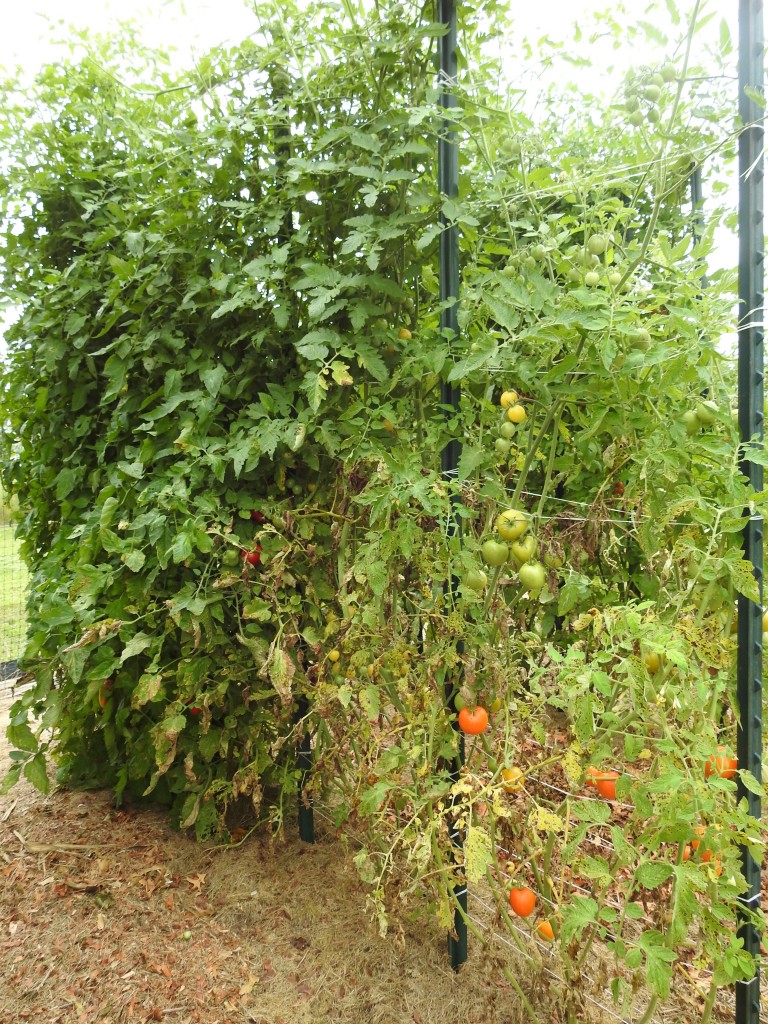As Cornell University’s vegetable pathologist doing research at the Long Island Horticulture Research and Extension Center (LIHREC) in Riverhead, NY, I’ve seen a lot of sick tomatoes over the years, and I’ve been posting photographs of what I’ve seen on my website: http://livegpath.cals.cornell.edu/gallery/. When not at work, I’m an avid home gardener, too, so I have first-hand experience with the diseases popping up in Long Island gardens. In fact, many photographs on my website were taken at home.

Septoria leaf spot symptoms usually first appear on the lowest, oldest leaves after tomatoes start to ripen.
This year my tomatoes have Septoria leaf spot, which started on one plant and has been slowly spreading to others. The spores of this fungal pathogen, Septoria lycopersici, are spread by splashing water. It hasn’t rained much this summer, and I usually water at the base of plants rather than use an overhead sprinkler, but the few rains we’ve had spread the pathogen a lot. Septoria gets into a garden when seed containing the pathogen or infected seedlings are planted, or a windy rainstorm moves it from a nearby infected plant. Once in a garden, this pathogen survives overwinter in tomato debris; hence the recommendations to remove infected plant debris and to rotate the areas where you grow tomatoes. Other diseases and disorders I’ve seen on my garden tomatoes include anthracnose and blossom end rot (both every year), drought stress on leaves, leaf mold, powdery mildew, and late blight, all of which appear on my website.

Small dark brown spots with tan centers containing very tiny black specks called pycnidia (spore structures) are characteristic of Septoria leaf spot.
Recently some colleagues and I at the American Phytopathological Society, including Dan Gilrein and Margery Daughtrey from LIHREC, developed a new app for smart phones called Tomato MD. It costs $2.99 and is available for both Apple and Android phones. Learn more about it here: http://www.apsnet.org/apsstore/shopapspress/pages/apps.aspx
This interactive reference tool is set up for fast identification of tomato problems, based on symptoms of root, leaf, stem, and fruit. The goal of the app is to move you quickly through the most difficult part of dealing with a sick plant: what’s wrong and what is causing it. The app includes an index of nearly 30 diseases and insect disorders, an extensive photo gallery of the most common problems, and a list of diseases according to their characteristics. Tomato MD does more than just help with identification; management tips are included, too.
For more help in identifying what’s wrong, take a look at my website (above), then read our online fact sheets about dealing with tomato problems, which can be found here: http://ccesuffolk.org/gardening/horticulture-factsheets/vegetable-diseases. If you’re still stumped, call our Horticulture Diagnostic Lab at our hot line at 631-727-4126 from 9 a.m. to noon, Monday through Friday, where Alice Raimondo and Sandra Vultaggio, our Horticulture Consultants, are available to answer all your horticulture questions.
Dr. Meg McGrath is Associate Professor at Cornell University’s Long Island Horticulture Research and Extension Center in Riverhead, New York, where she conducts research and extension activities to help farmers manage diseases.

